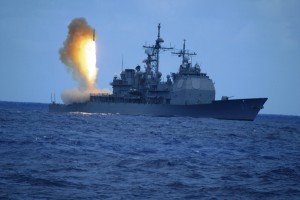 When former TOPGUN trainer and emergent LCS-killer Christine Fox, the Acting Deputy Secretary of Defense, demanded a “more capable [small] surface combatant“–namely one with innate air-defense capability–she did more than merely lay out a plan to kill a wayward surface-ship program. She offered a glimpse of what the Department of Defense (DOD) envisions as the future trajectory of American naval power and U.S. innovation at sea. DOD wants to fight like it is 1986.
When former TOPGUN trainer and emergent LCS-killer Christine Fox, the Acting Deputy Secretary of Defense, demanded a “more capable [small] surface combatant“–namely one with innate air-defense capability–she did more than merely lay out a plan to kill a wayward surface-ship program. She offered a glimpse of what the Department of Defense (DOD) envisions as the future trajectory of American naval power and U.S. innovation at sea. DOD wants to fight like it is 1986.
This vision of the future is worth discussing.
1. Like in ’86, DOD is tapping a deep-seated fear that America is at risk of losing uncontested air superiority at sea. Now, this, in itself, is not entirely controversial, given that almost every third-rate power out there can field some kind of strike platform or lob some kind of missile forward. And we certainly must acknowledge that 1) this trend will only accelerate over the coming years and recognize that 2) the air picture will become increasingly complex, cluttered by a bewildering number of manned and unmanned platforms.
This is America’s (and, likely, a former TOPGUN Analyst’s) nightmare. Ever since World War II, America has been particularly intolerant of air defense vulnerabilities at sea. Other countries, however, routinely operate forward while sporting considerably less air-defense than the typical forward U.S. platform–many ships in the international armada have no air defense capability or they resort to simply stashing a few Stinger missiles near the bridge (And they haven’t lost a ship lately, either!).
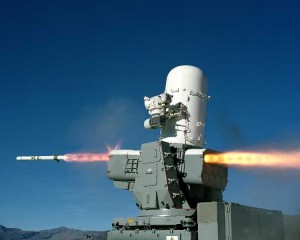 Now, contrary to rumor, the LCS is not defenseless. It goes to sea with a pretty good point-defense anti-air weapon (RAM or SEARAM, depending upon the type)–the same point-defense used by carriers and big amphibs (And, as an aside, some RAM missiles may have a modest anti-surface capability, too). Instead, our current defense tastemakers want to reduce risk by adding in something more immediately capable of taking the fight to the aircraft, as a source used in Chris Cavas’ excellent Navy Times piece, suggested:
Now, contrary to rumor, the LCS is not defenseless. It goes to sea with a pretty good point-defense anti-air weapon (RAM or SEARAM, depending upon the type)–the same point-defense used by carriers and big amphibs (And, as an aside, some RAM missiles may have a modest anti-surface capability, too). Instead, our current defense tastemakers want to reduce risk by adding in something more immediately capable of taking the fight to the aircraft, as a source used in Chris Cavas’ excellent Navy Times piece, suggested:
“The real need is for an escort to accompany convoys, logistic ships, even parts of the battle fleet. Analysis shows that as a gap. But LCS cannot provide air defense to ships it’s escorting — it only has self-defense,”
Wow.
That controversial admission suggests that DOD lacks confidence in the Armed Force’s ability to maintain air supremacy. It suggests we fear that our allies’ airborne resources will be insufficient, our carrier air wings will be absent, all our land-based aircraft will be elsewhere and even assumes the much-vaunted support from “Air-Sea Battle” will be gone. It suggests DOD expects significant air-defense deficiencies–and expects that, in the very, very near-term, the U.S. will be unable to provide battlefield coverage at sea. It suggests that the F-35 is ineffective and that the UCAS will not offer the all-weather, 24/7 coverage UAV-boosters suggest. Fine.
But it also suggests that America will be unable to provide effective air coverage even in uncontested, low risk areas where convoys and logistical ships are expected to operate.
If that doesn’t embolden competitors, I don’t know what will.
2. DOD is doubling down on weaponry (and tactics?) from the Eighties. I’ll be frank. The MK41 vertical missile-launch system (VLS) family was developed back in the seventies to house a missile family from the sixties. And, yes, there is a lot to like. As a system, it has chalked up a reliable record. It has evolved with the time. And everybody uses the same system.
But…aren’t those the same advantages battleship admirals claimed for rifled breech-loading heavy guns back in the 1920’s? It’s the exactly the same argument. (Interestingly enough, the timing of the gun’s design spiral to maturity and obsolescence is almost identical too–breechloaders started entering service in the 1860s, were argued about in the 1920s…and by 1941 they were, ah, bombed into strategic irrelevance)
So, rather than adopting something smaller and lighter, and force function into a newer, more efficient form, we’re going with a legacy program because, what? We don’t want to go through the pain, suffering and expense of designing a new, smaller launch system? Or pony up the cost of designing a much, much smaller missile? Or pay to develop an entirely new weapon? (I’m not even going to touch battle fleet organization here, but aren’t carrier battle groups kind of old-school?)
Rather than complete an Analysis of Alternatives for, say, bolting a cheap and easy SeaRam battery or two aboard auxiliary ships (um, how many incoming threats do we expect in a “low-threat” area, anyway? And weren’t UAVs and UCAVs supposed to provide 24-hour, all-weather air surveillance, early-warning and air defense, too?), our defense taste-makers are pressing to purchase a fully-burdened, legacy platform that is, in essence, designed for a war that has already happened.
If we go that route, we’ll pour a lot of money into developing something perfect for fighting and winning on a 1986-era battlefield. The ship will be chock-full of new versions of traditional Cold War weapons, hailed as an “instant classic” by a few Admirals who have fond memories of life at sea in the Eighties, and everyone in the anti-LCS crowd will love it.
But that ship will be obsolete at launch.
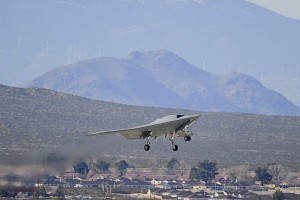 3. DOD assumes next-generation tech–UAVs and energy-weapons–are a bust at sea. Despite all the promise of rail guns, lasers, emitter-based disruptive energy weaponry and 24/7 all-weather air support from long-endurance UAVs, the DOD’s number #2 seems to be signaling that the U.S. will scale back R&D and innovation to pursue smaller, incremental advances of legacy systems.
3. DOD assumes next-generation tech–UAVs and energy-weapons–are a bust at sea. Despite all the promise of rail guns, lasers, emitter-based disruptive energy weaponry and 24/7 all-weather air support from long-endurance UAVs, the DOD’s number #2 seems to be signaling that the U.S. will scale back R&D and innovation to pursue smaller, incremental advances of legacy systems.
Look. The first Flights of LCS were starting to be seen as flexible platforms to advance fast-moving tech into the maritime battlefield in a relatively cost-effective fashion. LCS provided the Navy a modular platform with the space/weight/power margins to easily test new technologies, field them and then use them to build new concepts in naval warfare.
And that goal makes certain sense given the expected direction of naval warfare–if we assume, say, that threats in the air and sea domain will proliferate, the need to develop something capable, say, of finding and hitting/soft-killing an ever-growing number of “things” increases. With a laser, railgun or other aggressively-minded emitter, the magazine essentially reverts to an efficient, easily-stored and easy-to-resupply liquid form (or, even better, you’re in a ship with nuclear power!). Fuel, railgun pellets and spares seems to offer lot more flexibility than well, hoping the contents of your un-replenishing big steel VLS box are the right mix for the given threat of the day. And that was where the LCS could shine.
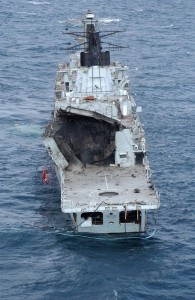 Inflexibility aside, VLS locks sailors into a firm, easily-identified-by-the-adversary numerical constraint–all while giving old-school, traditional ship-drivers sufficient confidence in their ability to enter the danger zone, survive long enough to fire off the contents of what will be an insignificant handful of VLS cells and, then…what? Take hits and die heroically in their Level II survivable platform?
Inflexibility aside, VLS locks sailors into a firm, easily-identified-by-the-adversary numerical constraint–all while giving old-school, traditional ship-drivers sufficient confidence in their ability to enter the danger zone, survive long enough to fire off the contents of what will be an insignificant handful of VLS cells and, then…what? Take hits and die heroically in their Level II survivable platform?
Is that really what we want?
In a world where threats are getting smaller and more numerous, the only way anyone can claim that VLS-launched missiles are the right thing is if the entire catalogue of future U.S. weapons are fatally flawed. That may be so…but, back in the day, even the quaint breechloader looked like an awfully risky proposition.
The heavy VLS, when coupled with legacy weapons and sensor suites, makes innovation that much harder and more costly. For a small ship, legacy systems weigh the vessel down, reducing the opportunities to try things that are truly innovative. Instead of getting something neat and new to sea early and often, we’ll be taking a combatant offline. For a long time. For a handful of innovations that may not work. (Hey, does anybody remember those really neat Mine Warfare-ready DDGs we made awhile back? How did they do?)
Look. I hate knocking VLS. It fits the “warfighting first” goal of the fleet. It looks, at first analysis, like a cost-effective route forward in comparison to other emergent systems. There are certainly a lot of advantages to taking a working, solid system and incrementally advancing it. There is certainly innovation to be had–the anti-ship ArcLight strike missile, for example. But at the end of the day, a VLS launcher is just a small, heavy box in a floating truck.
And right now, in this period of relative peace, is exactly the right time to start thinking out of the box, and to consider what else–beyond boxes–that our floating pickup trucks might carry forward to the fight in the evolving air-sea-subsea domain.
If we fight as we have been for the past thirty years, our supremacy will vanish as other countries develop similar-looking navies, and, we will, quite possibly, lose.
Conclusion:
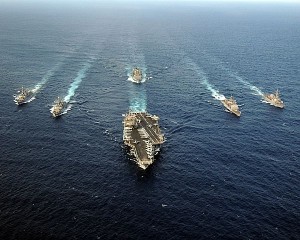 All levity aside, there’s something else that should trouble us all about Ms. Fox’s infamous memo. By doubling down on the Eighties-era VLS/Standard Missiles as our “main-gun” system, ceding the sky and hamstringing R&D, our defense tastemakers are signaling, in essence, two things.
All levity aside, there’s something else that should trouble us all about Ms. Fox’s infamous memo. By doubling down on the Eighties-era VLS/Standard Missiles as our “main-gun” system, ceding the sky and hamstringing R&D, our defense tastemakers are signaling, in essence, two things.
Either they have become so frightened by the impending cost-cuts that they’ve pretty much rejected clean-sheet naval innovation outright, or they think that the strategic threat at sea is so dire we no longer have time to indulge in clean-sheet innovations.
Neither option is good.
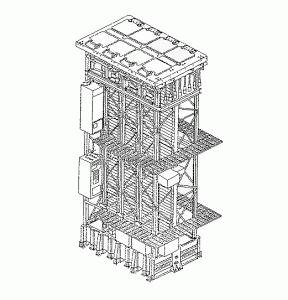

{ 19 comments… read them below or add one }
Quite aware, as I stated, the range at 40+ knots is between 1,000 – 2,000 nm depending on the variant. Just as I am aware the Burke is triple the displacement, carries a wide variety of weapons that out-range the LCS in any current configuration, carries two H-60 helicopters, and is capable of doing more than one mission without a trip to the shipyard. But that is an apples-to-oranges comparison.
With respect to the Burke’s speed, it is hardly germane to the question of whether the LCS’ high sprint speed is worth the cost in reduced payload capacity. You maintain it is valuable in ASW work, on what basis? The offensive component of the ASW module is the embarked helicopter. The helo will be dropping the torpedo, not the ship. The helicopter is faster than the submarine. Sprinting will degrade the ship’s sonar performance to some degree and shout the ship’s presence to the submarine. Endurance to maintain and prosecute a contact would be more useful than a 40+ knot sprint. With modern AIP SSKs equipped with ASCMs that can be fired from well over the horizon, what utility will the 40+ knot speed have? The sprint speed will be used how often, for how long ,and up to what sea state? Is this speed so valuable as to have permanently compromised payload and endurance? I suspect not.
I do not buy insurance because I use it every day, but for the times when the house is on fire. The “C” is for combat, not cocktails. Part of presence is deterrence. Exactly who, beyond pirates, is going to be deterred by a ship that cannot shoot past the horizon? No one in a crisis is going to ask, “Where is the nearest LCS squadron?” Unless it is so to order them to sprint to safety.
On the subject of smaller corvettes, there are corvettes out there at less tonnage and for substantially less money with the same or more firepower. The point of looking at other nations is less about buying the exact design, but more at what is possible. By way of example, how about the Russian Steregushchy class. A bit more than 1,500 tons, but it carries a helicopter, a bigger gun, and a longer range missile. Cost $150M. 40 or 50 knots will not out run a Mach 0.8 anti-ship missile. Or perhaps the French Gowind family of corvettes. Or perhaps the Dutch Sigma class. None will run at 40+ knots, but they all can carry a helicopter, cost less, and are more heavily armed. I am not sure what “operating globally” is as far a requirement goes, but for the price of an LCS with a mission package three Steregushchy’s may be purchased.
You are likely correct that debating the merits of the LCS will continue, unresolved, until proved (hopefully never) in the real test of combat. I agree that the Navy needs more hulls; I just do not believe the LCS in its current configuration is the right hull. I do not believe it has struck the right balance between speed and payload.
John, I agree with you wholeheartedly.
Geoff–The range of the LCS-2 at 20 KTS is equivalent to a DDG-51.
Admin-Sigh. I stand corrected. But thank you for graphically making the point about refueling…something the LCS seems to spend a lot of time doing. Much like a 1,500t frigate, in fact.
The LCS is a ship that will obviously have some production legs in it and actual value, they will probably end up around 24-26 ships of a single hull class to further save on costs. The DoD reality is that it wants a Frigate back in the mix, the practical reality is the US Navy really needs a fully functional Frigate back in the mix. The sad reality of Washington, DoD and Navy Flagstaff is that politics and more importanly ego has gotten in the way of solving the problem. DC has problem of not willing to admit “we got it wrong” on anything. There is no honor, character or morale fortitude left inside the DC beltway. This is a problem that wont be fixed, ownership has been replaced with ineptitude.
Geoff– Sigh. Look at the photo at my prior post and you’ll see an LCS conducting an alongside replenishment.
“Find me one at 1,500 tons that is operating globally. That doesn’t need a tender. Find me one with capability to handle two H-60s. Find me one that goes 40KTs.”
LCS can “operate globally”…@14 knots IIRC. Reality is, that in a combat environment, the LCS is just as range restricted as a 1,500t frigate. 40KT…for a very short range, is very short-legged on primary propulsion, and as has been noted, you can’t outrun a missile. Is 40KT capability even relevant to any of the LCSs dedicated missions? Tenders…the LCS can’t refuel under weigh last I read, is so undermanned it requires a fast crew turnover. I’d also note, that non-survivable ships don’t require a tender. 2 helos…for the cost of an LCS, you could have 3x 1500t hulls, each with a helo.
Can we really afford to spend billions of dollars on a 3200t class of minimally survivable ships that do nothing hulls a fraction of the size and cost already can and do perfectly well? That’s the bottom line, the real discussion, everything else is just blah, blah, blah.
All the “good” in the LCS concept has been negated by bad design, poor planning, and shoddy construction. We’re left with a greatly compromised design, over-sized, over-weight, over-priced, and under-performing.
But…they probably would make great CG cutters…albeit the most expensive ones in history…
Chris.
Hate to rebuff you on something, but you do know that at 20KT the INDY class pretty much matches the DD-51 range, right? Yes, it doesn’t have legs to go far at 40 KT, but, ah, neither does the DDG-51. Because it can’t. (I wonder…if we’ve forgotten what sprint speed and maneuverability offer in ASW…)
From where I sit, I see the Navy doing far more, as you say with distain, “piracy cruises” (I say shaping, Special Ops and needed intel missions) than high-end warfare. We rarely do high-end warfare. I think, right now, you get more bang for your buck filling in the useful, “be everywhere” platform niche (a niche that has been woefully underfunded in favor of preserving the high-end platforms like DDG). We have 83 DDGs and CGs, down from 105 (less capable!) ones in 1985. We went from 115 frigates to, what, 12 today? For all the whining, once the big guys are relieved of their “piracy cruise” duty by smaller craft, the Battle Fleet should be in pretty good shape. The Battle Fleet will need more helo support (which was once provided by FFGs)–which an LCS can certainly provide.
As far as capability and cost go, I think you’re crazy to believe that a foreign hull can enter into the USN without facing substantial runups in cost. NAVSEA won’t allow it, and by time they are done, you’ll get something quite good, but priced far higher than originally expected. The old Canadian Iroquois class hullform was a template for subsequent US platforms–but by the time we were done, the end product (Spruances, Ticos etc.) carried a far-higher price than the original model. Same thing happened with the foreign hullforms used in LCS. Unless something changes, the very same thing will happen with STANFLEX, or MEKO or FREMM hulls or whatever we pick. Mark me, those cheap Dutch designs we both love will be very different after the blueprints hit the Navy Yard.
You also say that there are corvettes out there that compare favorably in capability and cost at half the displacement. OK, quick! Find me one at 1,500 tons that is operating globally. That doesn’t need a tender. Find me one with capability to handle two H-60s. Find me one that goes 40KTs. The Dutch STANFLEX combatant is 6,000+ tones. The DDHs are even larger.
Anyway…I do think that we could argue this forever. But let me suggest that we’d agree on this one point–we’ve systematically de-funded small combatants to the point where we need far more hulls in the water than we have today.
Re: John’s comment about needing new cruisers… is there really a need to invest shipbuilding dollars into a new cruiser design, just to say that we have cruisers? If the only justification is “the Ticos are retiring and we need new cruisers…” well… I’m not in favor of building ships just to build ships. The Navy doesn’t have battleships anymore and if the Navy stops having cruisers, life will go on.
So to me the question is, what will a CG(XX) do that a Flight III Burke won’t do, and how important is that capability? Because every dollar spent on a CG(XX) is a dollar not spent on some other shipbuilding need.
Thanks for the reply.
RIM-116 Block 2 vs ESSM, 57mm vs 76mm, Harpoon vs Griffin, are all point debates under the general question of whether or not LCS brings enough capability to the fight, a real fight, not anti-piracy cruises. The CNO says it is payload not platforms after all. LCS critics and defenders alike will stipulate that affordability and upgrade-ability are desirable attributes. In light of the reported anti-surface warfare module contents and organic weaponry, I have serious reservations. The LCS variants do not compare favorably in capability or cost with other nations’ corvettes that are half the displacement. Shifting focus to the threat set in the Western Pacific requires more robust, capable platforms than hunting pirates or practicing search and rescue missions do. As a node in a networked force it contributes too little. LCS is too expensive to be expended in the littorals and too lightly armed to stand as a frigate.
LCS modules may be upgradeable, but the ship’s power plant is far from plug and play. The shaft horsepower to move at 40+ knots has no bearing on the ships power distribution system. An integrated system utilizes a common electrical bus for allocation and through flexible distribution and switching architecture, the common electrical bus can supply electrical power to both non-propulsion and propulsion electrical loads and instantly redistribute power as necessary. That is not something that can be easily bolted on.
As an aside, the 40 knot sprint speed was purchased at too high a price in terms of payload. I would argue that the capability is close to useless because 40 or 30 knots is irrelevant in the face of supersonic anti-ship missiles. Furthermore, without an oiler every 1000 to 2000 nautical miles (depending on variant) the LCS is not going very far at 40+ knots.
Any weapon system is scalable. Guns scale from.22LR up to 18”, missiles from man portable Stingers up to ICBMs. The larger point and question is the LCS’ capacity to carry a useful load. Could a laser or rail gun’s size, weight, and power footprint be effectively scaled down to fit into an LCS hull and still be effective? Maybe given enough time and money.
Fundamentally, does the LCS have a useful payload? For my money and fantasy fleet, I would consider a wider range of hulls than the LCS. There was some merit in the Street Fighter concept, but that called for much smaller hulls. Less than 1,000 tons. Such ships would probably need a tender, perhaps an MLP like vessel, in attendance. Second, a true affordable, multi-mission frigate is needed. The Danish STANFLEX family is a starting point. I would also contend that a ship similar to the new Japanese DDH would be useful for many of the missions under consideration.
To be clear, it’s the DOD who is telling the DON what to buy. Does that align with Navy wishes? Probably not (SECNAV argued for more ships and won) and probably yes (new ship designs are proceeding apace). Who knows? Maybe Greenert, but he sure ain’t talkin’.
You do know that Germany is pushing to adopt the RIM missile to surface targets, right? (probably because they have a few ships relying upon RIM missiles..) Also, helos….we forget that 1) helo hangars are leaving the fleet at a rapid clip, and 2) whenever helos go against small surface targets, they win.
Regarding torps. Look at the small tactical torpedo and how that’s being used (search for the “tiny tactical torpedo” on this site. Anyway, lots of neat stuff can get hucked out the back of these things…and subsurface guys would likely be hard-pressed to detect anything untoward until it was (BOOM) too late.
Also…VLS. Both LCS have designs with VLS and fancy radars incorporated. Not a big stretch. Just pricey.
Cheers!
LCS doesn’t need harpoon- but 4 penguins or NSMs on deck would be useful (also used by the helos on board as well). Critics of the 57mm gun seem overdoing it- it would probably better in an air defence or anti-SSM mode than the 76mm. But is clear it needs a better way to engage small boats than the griffin. I also don’t understand why it doesn’t carry a few heavyweight torpedoes for ASW. Adding a VLS system would require an extensive redesign. In fact the USN probably doesn’t need more tha the reduced buy & does need a more capable escort ship
Thanks for commenting.
I am always amused at how the advocates for a robust Navy always seem to forget logistics. They always come at you with a laundry list of cool stuff, but those peksy mundane (and vital) things like, oh, T-AO(X)s or the need for wide-ranging diplomatic support or wider presence never seem to get on the list.
Look, banging stuff up from an awesome, horribly-beweaponed cruiser is great fun. I’d love to have a Navy you describe. But, unfortunately, a lot goes into supporting the pointy end we both love.
I have to agree with Chris. The LCS is a $470M speedboat that lacks the firepower necessary to be called a warship and it’s time the Global Force for Good put the war back in warship. Thinking back to Donnie Rumsfeld, he said you go to war with the Army you have…same thing applies to the Navy. The concept of an LCS might be good, but turning 1/6 of the entire US Navy into a brown water fleet is a strategic mistake that risks the security of the global commons and SLOCs. End LCS Now. Build warships that can fight contemporary enemies. 1. Build a new class of hypersonic SSMs 2. Build a new cruiser 3. Build an escort Frigate 4. Build an SSBN replacement … and we can’t wait 15 years to see the first hulls as Greenert suggests. My God…really 15 years???
Interesting comment Chris, and I’ll be glad to respond. First off, let me address a few items in your note.
Lockheed and Raytheon would be glad to do what they do to their missile-sets. They’re already bringing it to the RIM–The RIM Block II missile’s range will double the effective RAM/SeaRAM range. RIM Block two will double the range. Not quite ESSM, but getting closer.
I know for a fact that one LCS can carry Harpoon (Navy didn’t want it), and if it can be bolted-onto one variant pretty easily, I assume it can be done to the other. Do we NEED Harpoon right now? Probably not. But if we did, we could bolt it on quite quickly.
I like the current LCS gun…If it were used to it’s maximum ability, it, too, could be used to support self-defense. There’ s not a hell of a lot of difference between the LCS gun and the 76mm aside from the fact that we bought a ton of ammo for the 76mm that is still lying about and we have a cadre of folks who trained up on 76mm (as one FFG sailor told me as he was showing me his workspace, “this is what I’m trained to operate, and with LCS I’ll need to start over!”). As far as platform suitability for the 76mm, both LCS can accept it. You’d need to do some design work on INDY, but nothing too substantive.
As far as power-generation and suitability for energy weapons, I’ll just say this. Energy weapons are scalable. You can have a tiny railgun, or a big railgun or a medium-sized one. A big laser or a small laser. Yes, you may not be able to hang a railgun meant for eventual placement on DDG-1000 on an LCS, but, again, tell General Atomics or BAE or Lockheed to make it smaller, they will. One of ’em may already have. And then there’s the sensor suites. But I digress.
Any ship that generates enough power to go 40+ knots can be rejiggered to handle energy weaponry.
I am a big STANFLEX fan. But it doesn’t swap out as fast as advertised. In fact, our modules (such as they are) may swap out a bit faster than advertised. The LCS CONOPS is overconservative bullshit, and was largely written by folks who wanted to kill it (or were–to put it charitably–unfamiliar with one variant versus the other). I think the JHSV’s experience changing out mission sets (with 22 crew, mind you) will, over time, amply demonstrate the LCS CONOPS isn’t worth the paper it’s printed upon.
Anyway, thanks for writing in. I enjoy the debate, and hopefully you’ll be back to contribute more!
In may be technically accurate to say the LCS is not defenseless, but that is all. SeaRAM has a range of 5 nm. Foreign navies operate without air coBy way of comparison, Australian FFG-7, using that obsolete Mk 41 VLS carries ESSM with a range of 27 nm. Which would you prefer? Taking the comparison further, the FFG-7 also has a bigger gun (very passé) as well as carrying Harpoon. Harpoon’s 67nm range is also a lot bigger than the LCS anti-surface module’s Griffin or Hellfire range of about 3 nm. Which would you prefer?
VLS may date from the eighties, but the missiles it carries do not. That’s one of the central advantages of VLS. You can easily upgrade (i.e. it is modular) the missiles. Unfortunately, LCS is too small to carry it. Lockheed or Raytheon I am sure would be more than happy to try and invent a smaller, lighter, but more powerful missile to squeeze onto an LCS. Given enough time and money this magic missile might eventually materialize. Smaller missiles have smaller amounts of propellant and smaller warheads. It is physics. BTW, a technical point, all modern guns are breechloaders. Being a breechloader has nothing to do with the argument surrounding the efficacy of large caliber main batteries vs carrier aviation.
No reporting that I have seen, certainly not the Navy Times article, has said anything to back the hysterical comment that the Navy is abandoning rail guns and lasers. The LCS does not have the space or power margins for either of those systems. The Freedom variant has already had weight and stability issues that required bolt-on buoyancy fitting at its stern. The Independence variant cannot even accommodate a 76mm gun, so in what reality would a railgun be squeezed in? Furthermore, neither variant has an integrated power system that would be key to energy based weapons, only a DDG-1000 currently has that.
Perhaps the real story is that OSD finally threw the BS flag on buying upgunned Coast Guard cutters to form 1/6 of the fleet. If modularity and affordability are the goals, and laudable ones at that , look at the Danish STANFLEX system. STANFLEX was developed in dreaded 1980s, but it works and module swaps are a lot faster than those conceived under LCS’ reported CONOPS. The LCS is an example, like the JSF, of acquisition mal-practice. The Navy attempted to cross a frigate replacement with the Street Fighter concept mixed a little Rumsfeld transformation secret sauce to create two ships designs that can hunt pirates and make nice with small navies. Hardly key components for the battle fleet “pivoting” to the Pacific.
The key going forward for all surface combatants is power generation. There is simply no available power source both small and powerful enough for a LCS size combatant to utilize sytems like AMDR, Railguns for FEL.
If every corvette-sized ship has to have long-range SAMs to be “satisfactory” in the air defense category, S O, what capabilities are you willing to sacrifice on those hulls, and how many fewer ships are you going to be able to build and operate given the increased costs and manning requirements you’ve just imposed?
Related to point one; LCS doesn’t even have satisfactory self defence against aerial threats:
http://cimsec.org/look-corvettes-air-defense/